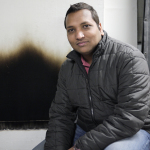Ajay V. Singh
Ph.D. Thesis : A Fundamental Study of Boundary Layer Diffusion Flames
Advisor: Dr. Michael J. Gollner
Sponsor: Minta Martin Foundation, University of Maryland College Park
Modeling the realistic burning behavior of condensed-phase fuels has remained out of reach, in part because of an inability to resolve complex interactions at the interface between gas-phase flames and condensed-phase fuels. This interaction is even more complex as scales increase, because realistic fires occur under fully turbulent conditions which have yet to be fully replicated or understood at the bench scale, where detailed measurements can be conducted. The current research explores the dynamic relationship between combustible condensed fuel surface and gas-phase flames in both laminar and turbulent boundary layers, representing the small scales in which materials are tested (where much of today’s theoretical knowledge is also isolated) to realistic large-scale turbulent flames present in almost all unwanted fires, hybrid rocket motors and other similar combustion phenomena.
A thorough numerical and experimental investigation of laminar boundary-layer diffusion flames established over the surface of a condensed fuel is explored. By extension of the Reynold’s Analogy, it is hypothesized that the non-dimensional temperature gradient at the surface of a condensed fuel is related to the local mass-burning rate through some constant of proportionality. First, this proportionality was tested by using a validated numerical model for a steady flame established over a condensed fuel surface, under free and forced convective conditions. Second, the relationship was tested by conducting experiments in a free-convective environment (vertical wall) using methanol and ethanol as liquid fuels and PMMA as a solid fuel, where a detailed temperature profile was mapped during steady burning using fine-wire thermocouples mounted to a precision two-axis traverse mechanism. The results from the present study suggests that there is indeed a unique correlation between the mass burning rates of liquid/solid fuels and the temperature gradients at the fuel surface. The correlating factor depends upon the Spalding mass transfer number and gas-phase thermo-physical properties and works in the prediction of both integrated as well as local variations of the mass burning rate as a function of non-dimensional temperature gradient. A unique methodology was developed to estimate the local mass burning rates and flame heat fluxes for laminar boundary layer diffusion flames using both liquid and solid fuels. Convective and radiative heat feedback from the flames were also measured both in the pyrolysis and plume regions by using temperature gradients near the wall.
Figure 1: Flame and combusting plume photographs and temperature contours (experimental) for a (left) methanol and (right) ethanol boundary layer di ffusion flame.
The work will subsequently be extended to turbulent boundary layer combustion and associated interactions between turbulence and gas-phase heat release that drive the heat flux to the fuel surface will be further investigated. This turbulence will be introduced primarily in a uniform manner, through grid-generated turbulence, but the effect of shear-generated turbulence along the length of a boundary layer will also be explored through high speed imaging and detailed temperature and heat flux profiles (using micro-thermocouples and high frequency heat flux gauge). Central to this approach is knowledge of the local mass burning rates of condensed-phase fuels, which will be determined by temperature gradients near the surface of the fuel, utilizing a methodology proposed earlier. While this methodology is based upon laminar assumptions, it is hypothesized this technique should follow a similar form for turbulent burning of a fuel surface, albeit with a modified functional relationship which must be experimentally determined.
Figure 2: (left) Photograph of the experimental setup used to measure mass-loss rates and temperature profiles over a vertical, free-convection diffusion flame. (right) Front and side-view photograph of a vertical ethanol diffusion flame.
Figure 3: (top) Photograph of the laboratory-scale wind tunnel used for studying laminar and turbulent boundary layer combustion under forced flow. (bottom) Side-view photograph of an ethanol diffusion flame in a forced flow.
Articles in Refereed Journals
1. Singh, A.V. and Gollner, M.J., Experimental Methodology for Estimation of Local Heat Fluxes and Burning Rates in Steady Laminar Boundary Layer Diffusion Flames, Journal of Visualized Experiments, 2015 (In Press).
2. Singh, A.V. and Gollner, M.J., Local Burning Rates and Heat Flux for Forced Flow Boundary-Layer Diffusion Flames, AIAA Journal, 2015 (In Press).
3. Singh, A.V. and Gollner, M.J., A Methodology for Estimation of Local Heat Fluxes in Steady Laminar Boundary Layer Di ffusion Flames, Combustion and Flame, Vol. 162, No. 5, 2015, pp. 2214-2230.
4. Singh, A.V. and Gollner, M.J., Estimation of local mass burning rates for steady laminar boundary layer diff usion flames, Proceedings of the Combustion Institute, Volume 35, No. 3, 2015, pp. 2527-2534.
5. Singh, A.V., Eshaghi, A., Yu, M., Gupta, A.K. and Bryden, K.M., Simultaneous time-resolved fluctuating temperature and acoustic pressure fi eld measurements in a premixed swirl flame, Journal of Applied Energy, Vol. 115, 2014, pp. 116-127
6. Singh, A.V., Yu, M., Gupta, A.K. and Bryden, K.M., Investigation of noise radiation from a swirl stabilized diff usion flame with an array of microphones, Journal of Applied Energy, Vol. 112, 2013, pp. 313-324.
7. Singh, A.V., Yu, M., Gupta, A.K. and Bryden, K.M., Localization of multiple acoustic sources in a room environment, Journal of Applied Energy, Vol. 109, 2013, pp. 171-181.
8. Singh, A.V., Yu, M., Gupta, A.K. and Bryden, K.M., Thermo-acoustic behavior of a swirl stabilized di ffusion flame with heterogeneous sensors, Journal of Applied Energy, Vol. 106, 2013, pp. 1-16.
Ajay Singh is a doctoral candidate in the A. James Clark School of Engineering. He obtained his Bachelors in Mechanical Engineering and Masters’ in Aerospace Engineering both from India. His research- interests include boundary layer diffusion flames, wildland fires, combustion and reacting flows, fire dynamics and aircraft propulsion systems. For further information about his work, he can be contacted at:
ajayvs@umd.edu
Phone: 301-575-6043




